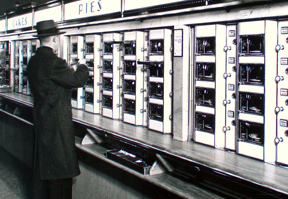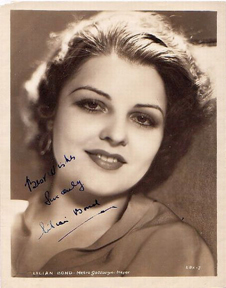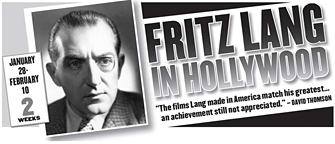Here are 10 things you should know about Ian Wolfe, born 125 years ago today. In a career that spanned 72 years, he made, by one estimate, more than 1,900 combined appearances on the stage, in movies, on radio and television.
Tag: Sylvia Sidney
A Nickel’s Worth of Grub at the Automat
 We are fascinated by Automats, those self-serve restaurants that asked diners to drop nickels in slots in order to raise one of dozens of small glass doors to access a serving a meatloaf or apple pie.
We are fascinated by Automats, those self-serve restaurants that asked diners to drop nickels in slots in order to raise one of dozens of small glass doors to access a serving a meatloaf or apple pie.
Horn and Hardart opened the United States’ first Automat in Philadelphia in 1902, but they are mostly closely associated with New York City, where they thrived for decades before dying off in the 1980s and early ’90s. There were only a handful remaining when we arrived in the Big Apple in 1982, and we just made it to the last one before it closed in 1991.
But the Automat lives on in old (and not-so-old) movies, and we’ve devoted a playlist on the Cladrite Radio Youtube channel to scenes depicting these grand old eateries.
The most recent addition, from a 1925 silent called The Early Bird, can be viewed below, but if you wish to see full playlist of a dozen clips (and you do, take it from us), just follow this link. You’ll enjoy scenes featuring Joan Crawford, Ray Milland, Jean Arthur, Doris Day, Cary Grant, Debbie Reynolds, Sylvia Sidney, and many more.
Mirror Images: Jane Leeves and Lillian Bond
What sweeter treat could exist for any classic movie buff than to see oneself (or a more-than-reasonable facsimile thereof) on the silver screen in a movie from the 1920s, ’30s, ’40s, or ’50s?
No, we’ve not discovered our own cinematic doppelganger, though we’d like nothing more.
But we have found, over time, a handful of actors from the Golden Age of Hollywood who very strongly resemble prominent contemporary figures (and we’d love to hear from you, the members of the Cladrite Community, if you’ve found some we’ve missed).
Our first pair of (nearly) identical twins separated by several decades is the lovely contemporary actress Jane Leeves, best known for playing Daphne Moon on the long-running hit television show Frasier, and her Golden Age lookalike, actress Lillian Bond.
Don’t you agree that, allowing for differences in the hair and make-up styles of their respective eras, these two are very close to a matched set? At the very least, Leeves would be an ideal choice to play Bond if ever there were a biopic called “The Lillian Bond Story” produced.
 |
 |
These very alluring mirror images are/were both English by birth, with Bond having been born and raised in London and Leeves making her debut in lford, Essex, and growing up in East Grinstead in Sussex.
Bond often played the “other woman” in pictures (as she does in the clip below), while Leeves has long specialized in comedic roles.
So while their careers may not have been similar, we think their facial features are strikingly so. And we envy Jane Leeves that—not because we wish we resembled Lillian Bond, but because we think it’d be fun to be watching an old movie late one night and suddenly see “yourself” acting in it.
Below are two clips featuring the actresses. The first features Leeves in an episode of Frazier; the second finds Bond appearing opposite the lovely Sylvia Sidney in a 1933 picture called Pick-Up. See if you don’t agree there’s a very strong resemblance.
Film Forum fetes Fritz's hits
 If you’re anything like us and you happen to reside in or around New York City, you plan to make an almost daily pilgrimage to West Houston over the two weeks for “Fritz Lang in Hollywood,” a two-week retrospective at Film Forum.
If you’re anything like us and you happen to reside in or around New York City, you plan to make an almost daily pilgrimage to West Houston over the two weeks for “Fritz Lang in Hollywood,” a two-week retrospective at Film Forum.
The GermanAustrian-born Lang would be a revered figure in cinematic history even if he’d never set foot in Southern California. Such influential classics as Metropolis (1927), Spione (Spies, 1929), the Dr. Mabuse trilogy, and M (1931) ensure that.
But Lang became a very important director in the United States, too, beginning with his first Hollywood feature, Fury (1936), starring Spencer Tracy and Sylvia Sidney, which closes the Film Forum series as the 22nd of Lang’s 29 Hollywood pictures to be shown.
While in Hollywood, Lang showed a penchant for cinematic takes on pulp fiction—films noir, westerns, thrillers and espionage adventures—but he never settled for by-rote takes on these familiar genres. He gave his pictures a very particular look and dark mood, with the Expressionism of his making films in Germany clearlly influencing his American efforts.
You can’t go wrong with any of the bills during the series, but we especially recmommend the aforementioned Fury on Feb. 10; You Only Live Once (1937), starring Sidney and Henry Fonda, which is paired on Feb. 9th and 10th with Lang’s gangster musical (!) You and Me (1938), and three terrific noir double-bills: The Woman in the Window (1944)/Scarlet Street (1945 on Jan. 30, House by the River (1950)/The Blue Gardenia (1953) on Feb. 8, and the series-opener, The Big Heat (1953)/Human Desire (1954) on Jan. 28-29, both of which star noir royals Glenn Ford and Gloria Grahame.
If you’re familiar with Lang’s work, you’ve no doubt already got this great retrospective marked in your calendar. If you’re not, clear your calendar now and check out the series’ full line-up to plan which pictures you intend to see. You can thank us later.
